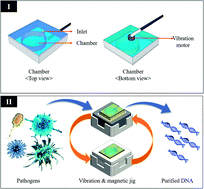Development of a bacterial DNA extraction modular chip using a magnetic particle and portable vibration motor
Abstract
A novel modular chip-based bacterial DNA extraction device was developed to overcome limitations associated with conventional DNA extraction processes that involve lab-scale instrument systems. The DNA extraction modular chip consists of a core chamber, a magnetic jig, and a vibration jig. The vibration jig allows the precise blending of solutions such as a lysis buffer and target bacterial samples. The magnetic jig houses magnetic particles, which are modified with amine-family chemicals, to specifically immobilize bacterial DNA. Bacterial lysis and DNA extraction were shown to be simply performed by physically connecting the core chamber to both of the jigs. The performance of the developed modular chip was verified by real-time polymerase chain reaction (PCR) with post gel electrophoresis, and Escherichia coli O157:H7 was selected as a target bacterial species for testing. As a result, 1.0 × 101 colony forming unit (CFU) E. coli O157:H7 was effectively extracted using the modular chip. This confirmed that the developed DNA extraction chip may be simple and effective enough to use in the field. The developed chip shows high potential for functional expandability to ultimately be used in the molecular diagnosis of various pathogens.



 Please wait while we load your content...
Please wait while we load your content...